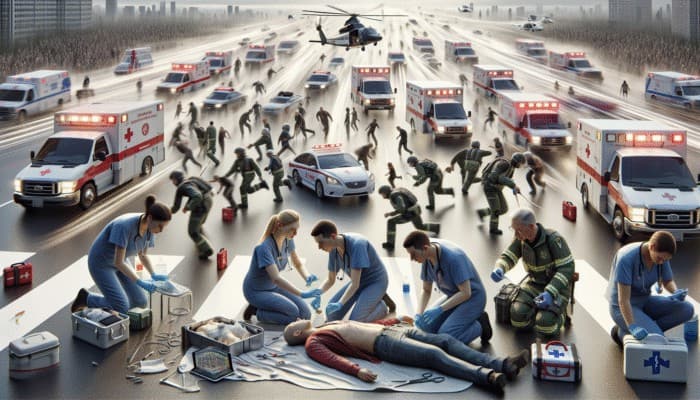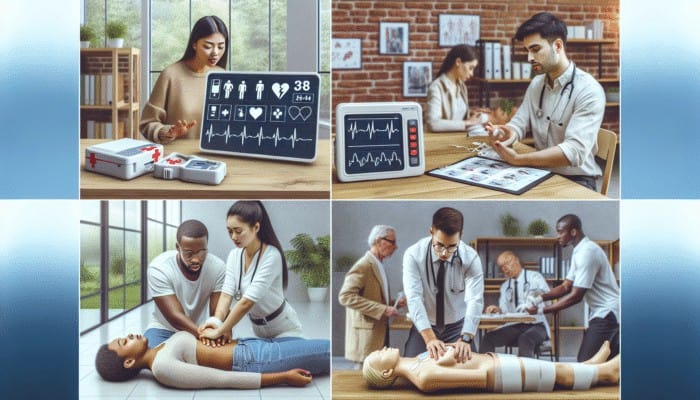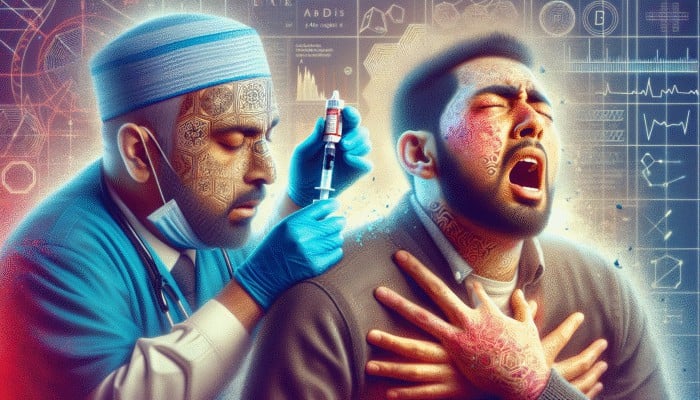Mastering Essential First Aid Principles for Emergency Situations
First Aid in Emergencies: First aid in emergencies transcends mere skill; it serves as a critical lifeline that can dramatically influence outcomes during life-threatening situations. The capacity to deliver immediate assistance not only enhances survival rates but also optimises recovery prospects. By developing a comprehensive understanding of first aid principles, individuals can respond swiftly and effectively to minimise the repercussions of medical emergencies on themselves and those around them. Whether you find yourself hiking in the wilderness, enjoying a lovely family picnic, or managing an incident at work, possessing the knowledge of how to react when an emergency occurs is incredibly empowering and vital for safety.
The Crucial Role of First Aid in Emergency Response

Every day, countless individuals encounter situations where urgent medical assistance is needed. Research underscores that prompt first aid can significantly mitigate the severity of injuries and, in some circumstances, even save lives. By grasping the essentials of first aid in emergencies, individuals can render the necessary care until professional help arrives, which is crucial not only for trained professionals but also for everyday citizens.
Imagine a bustling public event where someone suddenly collapses. The rapid intervention of a bystander equipped with first aid training could be the decisive element between life and death. The significance of first aid extends beyond physical injuries; it also encompasses providing emotional support and psychological assistance during times of distress. Being prepared to respond effectively not only empowers individuals but also instills confidence and compassion in their actions.
Furthermore, undertaking first aid training cultivates a sense of readiness that can greatly enhance community safety as a whole. When a greater number of people possess these essential skills, the overall response to emergencies improves significantly. This heightened preparedness can nurture a culture of safety, making communities stronger and more supportive when faced with crises or emergencies.
Fundamental First Aid Techniques to Know
Mastering essential first aid techniques is crucial for anyone aspiring to provide effective first aid in emergencies. Techniques such as cardiopulmonary resuscitation (CPR), wound management, and splinting are essential skills that can be crucial in various emergency scenarios.
CPR is an indispensable skill that can potentially revive an individual experiencing cardiac arrest. This life-saving technique involves performing chest compressions in conjunction with rescue breaths, aimed at sustaining blood circulation and oxygenation until professional medical assistance can take over. Acquiring CPR knowledge equips you with a vital skill that can be applied in diverse situations, from home emergencies to public gatherings, ensuring you are prepared to save lives.
Wound management represents another critical first aid technique. Whether dealing with a minor cut or a serious laceration, understanding how to clean and properly dress a wound is essential for preventing infection and fostering healing. Employing techniques such as applying pressure to halt bleeding or using sterile dressings can significantly affect the recovery process, underscoring the importance of proper wound care knowledge.
Additionally, splinting is an indispensable skill when addressing fractures or sprains. Stabilising an injured area effectively helps prevent further harm and alleviates pain. The methods for proper splinting can vary based on the type of injury and its location, making it imperative to understand the fundamentals of immobilisation to assist effectively in such situations.
Essential Items for Your First Aid Kit
A well-equipped first aid kit is an indispensable companion in any emergency. Knowing what to include in your kit can facilitate a quick and effective response across various scenarios. Every first aid kit should encompass the fundamental essentials necessary to address common injuries and emergencies effectively.
Start by including basic supplies such as adhesive bandages, antiseptic wipes, and sterile gauze, as these items are critical for managing minor cuts and scrapes. Additionally, consider incorporating items such as adhesive tape and scissors to enhance the effectiveness of your wound care capabilities, ensuring you are prepared for any situation that may arise.
In more serious emergencies, your first aid kit should also contain items like a CPR face shield, an emergency blanket, and a tourniquet. These crucial tools can prove vital in life-threatening situations, particularly in remote or outdoor settings where professional help may be delayed.
Don’t overlook the importance of tailoring your first aid kit to your specific needs and activities. For instance, if you enjoy outdoor adventures, adding snake bite kits and blister care products can be beneficial, while parents may wish to include child-friendly items. Regularly review and update your kit to replace expired items, ensuring that it is always prepared for action when required.
Effective Strategies for Responding to Common Medical Emergencies

Being well-prepared to address common medical emergencies is a vital component of first aid training. Whether you are at home, in the workplace, or enjoying the great outdoors, knowing how to respond effectively can save lives. Recognising symptoms and executing appropriate actions are fundamental aspects of effective intervention during emergencies.
Recognising and Responding to Heart Attacks
Heart attacks remain one of the foremost causes of death worldwide. Identifying the symptoms is the crucial first step in offering aid. Typical indicators include chest pain, shortness of breath, nausea, and lightheadedness. Often, individuals may also experience discomfort radiating to the arms, back, or jaw, which can signify a heart attack.
If you suspect someone is having a heart attack, it is imperative to call emergency services without delay. While awaiting assistance, encourage the individual to sit down and maintain a calm demeanor. If they have prescribed medication, such as nitroglycerin, assist them in taking it as directed.
If the person becomes unresponsive, administering CPR may become necessary. Knowledge of CPR is vital; performing chest compressions can sustain blood circulation until professional help arrives. Additionally, using an Automated External Defibrillator (AED) can significantly enhance survival chances during such critical moments.
Education plays a crucial role in enhancing community responses to heart attacks. Awareness campaigns and training initiatives equip communities with the knowledge required to act promptly, potentially saving lives and fostering a culture of readiness in the face of medical emergencies.
Managing Severe Bleeding Effectively
Severe bleeding constitutes a medical emergency that demands immediate attention. Identifying the source of the bleeding is paramount for effective management. Direct pressure remains the primary method for controlling bleeding. Apply a clean cloth or bandage firmly to the wound and maintain pressure until the bleeding ceases.
If the bleeding persists, elevate the injured area above the heart if feasible. This action can help slow blood flow to the injury site. Never remove any objects that may be embedded in a wound; instead, apply pressure around the object to control bleeding effectively and minimise complications.
In scenarios involving significant blood loss, symptoms of shock may develop, including pale skin, rapid pulse, and confusion. It is vital to remain calm and continue monitoring the individual until professional help arrives, as swift action can mitigate the risks associated with severe bleeding.
Educating communities on managing severe bleeding empowers individuals to respond decisively during emergencies, enhancing overall safety and response capabilities in various environments.
Recognising and Handling Allergic Reactions

Allergic reactions can range from mild symptoms to life-threatening conditions, making it essential to understand how to identify and effectively treat these reactions. Common signs of an allergic reaction include hives, swelling, and difficulty breathing. In severe instances, anaphylaxis can occur, leading to the rapid onset of symptoms that necessitate immediate intervention.
Knowing how to utilise an epinephrine auto-injector can be a lifesaving skill. If someone is experiencing severe allergic symptoms, administer epinephrine promptly as directed. This medication acts quickly to reverse symptoms and can be critical in preventing life-threatening situations from escalating further.
After administering epinephrine, it is essential to call emergency services and closely monitor the individual. Even if symptoms appear to improve, further medical evaluation is necessary to ensure their safety. Providing education on recognising and responding to allergic reactions can significantly enhance safety in environments where allergies are prevalent, equipping individuals with the ability to act decisively in emergencies.
Essential First Aid Techniques for Injuries and Trauma
Injuries and trauma can arise unexpectedly, highlighting the necessity for everyone to be prepared to take action. From fractures to burns, knowing how to respond can minimise damage and facilitate proper healing.
Effective Treatment for Fractures and Sprains
Fractures and sprains are common injuries that can occur in various contexts, from sports activities to accidental falls. Recognising the signs—such as swelling, bruising, and an inability to use the affected area—is the initial step in providing appropriate aid.
Stabilisation of the injury is crucial. For fractures, immobilisation is necessary to prevent further injury. You can utilise splints or makeshift items, such as rolled magazines or towels, to create support for the affected area. Avoid moving the individual unless there is an immediate danger, as any movement can exacerbate the injury and lead to more serious complications.
For sprains, rest and elevation are key components of effective treatment. Applying ice can help reduce swelling and provide pain relief. Understanding how to manage these injuries effectively can expedite recovery and diminish the risk of future complications.
Education and training play a vital role in empowering individuals to confidently address injuries, ensuring that proper care and attention are readily available within a community.
Responding to Burns and Scalds
Burns and scalds can result from various sources, including fire, heat, and chemicals. Understanding how to treat these injuries appropriately is critical for minimising pain and preventing complications from developing.
For minor burns, cool the affected area under running water for at least ten minutes. Avoid applying ice, as it can cause further damage to the skin. Subsequently, cover the burn with a sterile, non-stick dressing to protect it from infection and promote healing.
Severe burns require immediate professional medical attention. Recognising the severity based on size and depth can guide your response. If the burn area is larger than the palm of the individual’s hand or involves sensitive areas such as the face, hands, or genitals, seek emergency care without delay.
Education on burn treatment and prevention is essential, as burns can occur in everyday situations. By equipping individuals with the knowledge of how to respond effectively, the risks of long-term damage can be significantly reduced, promoting healing and recovery.
Recognising and Responding to Head Injuries
Head injuries can be particularly concerning due to the potential for severe complications. Identifying signs of a concussion, such as confusion, headache, and dizziness, is crucial for providing an effective response and care.
If someone sustains a head injury, it is vital to seek medical attention immediately, especially if they exhibit symptoms like loss of consciousness or persistent vomiting. Monitor their condition closely and aim to keep them awake if possible until professional help arrives.
In the meantime, avoid giving them food or drink, as this could complicate potential treatment. Keeping the individual calm and ensuring they are positioned safely can help to minimise further injury, highlighting the importance of vigilance and care in such situations.
Education on head injuries is crucial within communities, particularly in sports settings and among children. Understanding how to assess and respond can significantly enhance safety and awareness, ensuring that individuals are prepared to act appropriately in the event of a head injury.
Proper Care for Cuts and Wounds
Cuts and wounds are commonplace injuries that can occur in various environments, emphasizing the need for knowledge of proper care techniques to prevent infection and promote healing. Begin by cleaning the wound thoroughly with soap and water to remove any debris or dirt that may lead to complications.
After cleaning, apply an antiseptic solution to disinfect the area, then cover it with a sterile bandage. Regularly monitor the wound for signs of infection, which may include increased redness, swelling, or the presence of pus, indicating that medical attention may be necessary.
In cases of deep cuts or wounds that do not stop bleeding, it is essential to seek professional medical attention promptly. Understanding wound care can empower individuals to manage injuries effectively, ensuring proper healing and recovery while minimizing the risk of complications.
Recognising and Managing Shock
Shock is a serious medical condition that can arise following traumatic injuries or significant blood loss. Being able to recognise the symptoms—such as pale, clammy skin, a rapid pulse, and confusion—is vital for providing effective aid.
If someone is experiencing shock, lie them down and elevate their legs to improve blood flow to vital organs. Maintaining a calm and comfortable environment for the individual is essential, as anxiety can exacerbate the situation and lead to further complications.
Seek emergency medical help immediately, as shock can escalate rapidly and lead to severe consequences if not addressed. Providing care and reassurance can make a significant difference while waiting for professional assistance to arrive, reinforcing the importance of timely intervention in critical situations.
Education on recognising and responding to shock can empower individuals to act decisively during emergencies, increasing the likelihood of positive outcomes and improving overall safety.
Emergency Care for Environmental Conditions: What You Need to Know
Environmental conditions can lead to serious medical emergencies if not addressed promptly. Understanding how to respond effectively to these situations is crucial for ensuring safety and well-being.
Recognising and Responding to Heatstroke
Heatstroke is a life-threatening condition that results from prolonged exposure to high temperatures. Recognising the symptoms—such as elevated body temperature, confusion, and rapid heartbeat—is essential for prompt action and intervention.
If someone displays signs of heatstroke, immediately relocate them to a cooler environment and begin cooling them down using cool water or ice packs. If they are conscious and capable of drinking, encourage hydration with water or electrolyte replenishing drinks.
Seek emergency medical help without delay, as heatstroke can lead to organ failure and death if not treated promptly. Education on heat-related illnesses is vital, particularly during the summer months or for individuals engaging in outdoor activities, to foster awareness and preparedness within communities.
Managing Hypothermia Effectively
Hypothermia occurs when the body loses heat faster than it can produce it, leading to dangerously low body temperatures. Recognising the signs—such as shivering, confusion, and extreme fatigue—is crucial for effective intervention and care.
If someone is suspected of having hypothermia, promptly move them to a warmer environment and remove any wet clothing. Gradually warm the individual using blankets or warm drinks, taking care to avoid using hot water or direct heat, as this can cause shock.
Seek medical assistance if symptoms are severe or do not improve rapidly. Education on recognising and addressing hypothermia can enhance safety in cold environments, particularly during winter sports or outdoor adventures, ensuring individuals are equipped to act appropriately in such situations.
Treating Dehydration: Key Strategies
Dehydration can occur in various contexts, ranging from exposure to heat to illness. Recognising the signs—such as dry mouth, fatigue, and dizziness—is essential for prompt care and intervention.
Encouraging fluid intake is the primary method of treatment for dehydration. Water and electrolyte solutions can effectively restore hydration levels. It is advisable to avoid caffeinated or alcoholic beverages, as they can exacerbate dehydration and complicate recovery.
In severe cases, professional medical help may be necessary, particularly if the individual is unable to drink or exhibits severe symptoms. Education on recognising and treating dehydration can significantly enhance safety during outdoor activities or in hot climates, equipping individuals with the knowledge to respond effectively to dehydration.
First Aid Procedures for Poisoning and Overdose Emergencies
Poisoning and drug overdoses are critical emergencies that necessitate swift and informed responses. Understanding how to identify and react to these situations can be life-saving.
Identifying Symptoms of Poisoning
Poisoning can occur from various substances, including household chemicals, plants, or medications. Symptoms can vary widely but may include nausea, vomiting, confusion, and difficulty breathing.
If poisoning is suspected, it is essential to call poison control or emergency services immediately. Do not induce vomiting unless specifically instructed, as this action can sometimes lead to further complications and harm.
Gathering detailed information about the substance involved, the amount ingested, and the time of exposure can help medical professionals provide appropriate treatment. Education on recognising poisoning symptoms empowers individuals to act quickly and confidently in emergencies, ensuring timely intervention and care.
Recognising and Responding to Drug Overdoses
Identifying the signs of a drug overdose is crucial for an effective response. Symptoms may include unconsciousness, slow or irregular breathing, and a bluish discoloration of the skin. If you suspect an overdose, call emergency services immediately to ensure timely assistance.
In cases of opioid overdose, administering naloxone can be a life-saving intervention. This medication works by reversing the effects of opioids and can restore normal breathing within minutes, proving critical during a crisis.
It is vital to monitor the individual closely until help arrives. Keeping them comfortable and ensuring they are in a safe position can prevent further complications. Education on overdose prevention and response can save lives, particularly in communities grappling with substance abuse challenges, fostering awareness and preparation among individuals.
Proper Handling of Chemical Exposure Emergencies
Chemical exposure can occur in various settings, from industrial workplaces to household products. Understanding how to respond safely is vital to minimising harm. If someone is exposed to harmful chemicals, immediately remove them from the source of exposure.
Rinse affected skin or eyes thoroughly with plenty of water for at least 15 minutes to minimise damage. If the chemical has been ingested, do not induce vomiting unless directed by poison control or medical personnel, as this could worsen the situation.
Seek professional medical help, particularly if symptoms persist or worsen. Education on chemical safety and response enhances overall awareness and preparedness in various environments, ensuring individuals can respond effectively to potential emergencies.
Providing First Aid for Mental Health Emergencies
Mental health emergencies can be just as critical as physical emergencies. Recognising the signs and knowing how to respond appropriately can provide essential support to those in distress.
Identifying Mental Health Crises
Mental health crises can manifest in various ways, including suicidal thoughts, severe anxiety, or panic attacks. Understanding the warning signs is crucial for effective intervention and support.
If you suspect someone is in crisis, approach them with compassion and empathy. Encourage open dialogue, allowing them to express their feelings without fear of judgment. This supportive environment can make a significant difference in their willingness to seek help.
While providing support, it is essential to encourage the individual to seek professional help. Knowing local mental health resources can facilitate timely intervention and ensure that they receive the assistance they need. Education on recognising mental health crises empowers individuals to provide crucial support in challenging situations, fostering a more understanding and compassionate community.
Offering Emotional First Aid in Crisis Situations
Providing emotional support during a mental health crisis can have a profound impact. Techniques such as active listening, validation, and reassurance can help de-escalate difficult situations and offer comfort to those in distress.
Creating a safe space for individuals to express their feelings without judgment is paramount. Please encourage them to share their thoughts and respond with empathy to their concerns, reinforcing their sense of safety and understanding.
In some cases, connecting individuals with professional resources can be beneficial. Recognising when to encourage seeking help can significantly enhance the support you provide. Education on emotional first aid equips individuals to offer meaningful assistance to those in need, fostering a culture of compassion and awareness.
Supporting Individuals in Crisis with Compassion
Remaining calm and composed during a mental health crisis is crucial. Your demeanour can greatly influence the individual’s response, providing them with the reassurance they need. Maintain a supportive and understanding attitude while also being mindful of your emotional state, as this can impact your ability to help effectively.
Effective communication is key in these situations. Use clear and compassionate language, maintaining eye contact to convey your engagement and sincerity in providing support.
Encourage the individual to reach out for professional help if necessary, as knowing local mental health resources can facilitate timely intervention. Education on supporting someone in crisis empowers individuals to act effectively when faced with mental health emergencies, enhancing the overall resilience of communities.
First Aid Considerations for Children and Infants
Children and infants are particularly susceptible to injuries and illnesses, making it essential to understand the unique nuances of first aid for this vulnerable age group.
Preventing and Responding to Choking Incidents
Choking is a leading cause of injury in children and infants. Comprehending how to prevent choking incidents involves being aware of common choking hazards, such as small toys, food items, and household objects that can pose a risk to children.
If a child is choking, recognising the signs—such as coughing, wheezing, or an inability to breathe—is critical for prompt action. For infants, employing back blows and chest thrusts can help dislodge the object causing the obstruction. For older children, performing the Heimlich manoeuvre may be necessary to relieve their distress.
Education on choking prevention and response techniques can create safer environments for children, empowering caregivers to act decisively and effectively in emergencies, ensuring the safety and well-being of the young ones in their care.
Understanding CPR Techniques for Children and Infants
Cardiopulmonary resuscitation (CPR) for children and infants differs from adult CPR, making it crucial to learn the appropriate techniques for effective intervention.
For infants, CPR involves gentle chest compressions combined with rescue breaths, using two fingers for compression. In contrast, for children, one hand may be used for compression while maintaining the same rhythm and technique as adult CPR.
Understanding the variations in technique can significantly impact outcomes in emergencies. Access to CPR training specifically tailored for children and infants equips caregivers with the skills necessary to respond effectively in life-threatening situations, thereby fostering confidence in their abilities.
Common Childhood Injuries and Their Treatments
Children are prone to a variety of injuries, ranging from cuts and scrapes to falls and burns. Recognising how to treat these common injuries is vital for ensuring prompt and effective care.
For minor cuts, it is essential to clean the wound thoroughly and apply a bandage to protect it. In cases of burns, cooling the affected area and covering it with a sterile dressing can help prevent infection and promote healing.
Knowing when to seek medical help is equally important. If an injury appears severe or does not improve, it is crucial to encourage parents or caregivers to consult a healthcare professional. Education on childhood injuries enhances the safety and preparedness of caregivers, ensuring they are equipped to respond effectively in eemergencies
Frequently Asked Questions about First Aid
What does first aid in emergencies entail?
First aid in emergencies refers to the immediate medical assistance provided to individuals experiencing a sudden injury or illness before professional help arrives.
Why is first aid training essential?
First aid training equips individuals with crucial skills and knowledge to respond effectively to medical emergencies, potentially saving lives and minimizing harm in critical situations.
What items should be included in a first aid kit?
A basic first aid kit should include adhesive bandages, antiseptic wipes, gauze, a CPR mask, scissors, and other items tailored to specific needs and activities, ensuring comprehensive preparedness.
How can I identify a heart attack?
Common symptoms of a heart attack include chest pain, shortness of breath, nausea, and discomfort radiating to the arms, back, or jaw. Prompt recognition and immediate action are crucial.
What should I do in case of severe bleeding?
Apply direct pressure to the wound, elevate the injured area if possible, and seek emergency medical help if the bleeding does not stop, as this can be life-threatening.
How should I treat a burn?
Cool the burn under running water for at least ten minutes, cover it with a clean dressing, and seek medical attention for severe burns that require immediate care.
What are the signs of shock?
Symptoms of shock can include pale skin, rapid breathing, confusion, and weakness. Immediate medical help is essential in these situations to prevent serious complications.
How can I assist someone experiencing a mental health crisis?
Approach them with empathy, encourage open communication, and suggest seeking professional help when necessary to ensure they receive the support they need.
What should I do if a child is choking?
For infants, administer back blows and chest thrusts. For older children, perform the Heimlich manoeuvre. Seek medical attention if the object is not dislodged promptly.
How do I perform CPR on a child?
For infants, use two fingers for chest compressions. For children, use one hand while following the same rhythm as adult CPR, ensuring the technique is age-appropriate for effective results.
Explore our world on X!
Emergency Wound Care: Essential Techniques and Tips
Comprehensive Guide to Emergency Wound Care What constitutes emergency wound care? Emergency Wound Care: Emergency wound care represents a vital aspect of first aid, focusing on the immediate treatment of injuries to avert further harm and infection. This type of care is crucial for stabilising the injury until professional medical assistance is accessible. The primary objective […]
Bleeding Control Tips: Essential Techniques
Comprehensive Overview of Bleeding Types and Their Management Identifying Various Types of Bleeding Bleeding Control Tips: Understanding the different categories of bleeding—arterial, venous, and capillary—is vital for effective medical intervention and treatment. Arterial bleeding is marked by bright red blood that spurts rhythmically with the heartbeat, indicating that it originates from high-pressure blood vessels. This […]
Surviving a Heatwave: Essential Tips and Strategies
Essential Steps for Preparing for Extreme Heat Building Your Supply Kit for Heatwaves Surviving a Heatwave: When gearing up for an impending heatwave, it is vital to ensure you have an ample supply of essentials for your well-being. The most crucial item on your list should be water; aim to have at least one gallon […]
Water Safety Tips: Essential Guidelines for All
Comprehensive Guide to Water Hazards and Safety Water Safety Tips: Water is an enchanting element, inviting us to immerse ourselves and discover its mysteries. However, it also hides numerous dangers that can transform a delightful day out into a tragic event. A profound understanding of these hazards forms the basis of effective water safety tips. […]






It’s really refreshing to see a blog post shine a light on the importance of mastering first aid principles. Often, we overlook this crucial skill set, thinking it won’t happen to us, but as you’ve rightly pointed out, emergencies can land in our laps when we least expect it, whether it’s a casual picnic or a hike.
Your exploration of the critical role that first aid plays in emergency situations really resonates with the current emphasis on personal empowerment in health and safety. I completely agree that having a solid grasp of essential first aid principles not only boosts confidence but can also be the determining factor in emergency scenarios.
You’ve hit the nail on the head! First aid is like that Swiss army knife we all wish we had in our back pockets—ready to spring into action, especially when that picnic suddenly turns into a scene from a disaster movie. I remember the time I tried to show off my cooking skills at a family barbecue and ended up with a minor culinary explosion (don’t ask). Having my first aid knowledge at the ready was a game changer—not just for me, but also for my poor overcooked sausages!
First off, I’ve got to say that your culinary explosion story made me chuckle. We’ve all had those moments in the kitchen where things go a little sideways. It’s amazing how quickly a simple meal can morph into chaos, right? It sounds like your first aid knowledge was a real lifesaver—not just for your sausages, but probably for everyone who was there too!
Your discussion on the importance of mastering first aid principles resonates deeply with me, especially as someone who has witnessed both sides of emergency response—where timely assistance saved lives and where a lack of knowledge hindered recovery efforts. The empowerment that comes from being trained in first aid cannot be overstated; it equips individuals to act decisively in moments where every second counts.
It’s interesting that you mention the two sides of emergency response because it really highlights how critical those first moments can be. I too have had experiences where having some basic first aid knowledge made a significant difference. It’s amazing how having just the right tools—or even just the right mindset—can change the outcome in a crisis.
You really hit the nail on the head when you talk about those critical first moments in an emergency. It’s often in those early seconds that the course of a situation can change dramatically. Your mention of basic first aid knowledge resonates with me—as you said, it can make a huge difference.
Absolutely! Being prepared can truly make all the difference. If you’re interested in enhancing your first aid skills further, check out this resource that offers valuable training and tools to help you feel more confident in any emergency situation.
https://survivalbite.com/LostFoods
I really appreciate how you highlighted the empowering nature of first aid knowledge. It’s true that having even just a basic understanding can make a huge difference in emergency situations. I remember when I was camping a few years back, and someone in my group suffered a minor but concerning injury. Thankfully, I had just completed a first aid course and was able to apply those skills right away. It felt like I was able to turn a scary moment into one where we could take control and manage the situation effectively.
You bring up such an important topic with your discussion on the essentials of first aid in emergencies. I resonate deeply with the idea that having first aid knowledge serves as a vital empowerment tool in our everyday lives. For instance, I recall a time when I was on a family hike, and another group nearby experienced a minor but alarming incident where someone fainted. Thankfully, a few individuals with first aid training stepped in quickly to assess the situation and provide assistance. Their confidence and ability to act decisively not only reassured the affected person but also calmed the surrounding crowd.